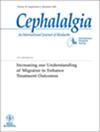Prevalence and characteristics of headache attributed to ingestion or inhalation of a cold stimulus (HICS): A cross-sectional study
IF 5
2区 医学
Q1 CLINICAL NEUROLOGY
引用次数: 3
Abstract
Background Headache attributed to ingestion or inhalation of a cold stimulus (HICS), colloquially called ice-cream headache, is a common form of a primary headache in adults and children. However, previous studies on adults are limited due to the small number of patients. Furthermore, most of the subjects in previous studies had a history of other primary headaches. Methods Biographic data, clinical criteria of HICS and prevalence of primary headache were collected by a standardized questionnaire. A total of 1213 questionnaires were distributed; the return rate was 51.9% (n = 629); 618 questionnaires could be analyzed. Results In a cohort of 618 people aged between 17–63 years (females: n = 426, 68.9%), the prevalence of HICS was 51.3% (317 out of 618). There was no difference between men and women (51.3% vs. 51.6%). The duration of HICS was shorter than 30 sec in 92.7%. In the HICS group, localization of the pain was occipital in 17%. Trigemino-autonomic symptoms occurred in 22%, and visual phenomena (e.g. flickering lights, spots or lines) were reported by 18% of the HICS group. The pain intensity, but not the prevalence of HICS, was higher when tension-type headache and migraine or both were present as co-morbid primary headaches (Numeric Rating Scale (NRS) 4.58 and 6.54, p = 0.006). There was no higher risk of participants with migraine getting HICS than for those who did not have migraine (odds ratio = 1.17, 95% confidence interval (CI) 0.75–1.83; p = 0.496). Conclusion The results of this study modified the current criteria for HICS in the ICHD-3 regarding duration and localization. In addition, accompanying symptoms in about one fifth of the participants are not mentioned in the ICHD-3. Neither migraine nor tension-type headache seems to be a risk factor for HICS. However, accompanying symptoms in HICS are more frequent in subjects with another primary headache than in those without such a headache.摄入或吸入冷刺激引起头痛的患病率和特征:一项横断面研究
背景:由于摄入或吸入冷刺激(HICS)引起的头痛,俗称冰淇淋头痛,是成人和儿童原发性头痛的常见形式。然而,由于患者数量较少,以前对成年人的研究有限。此外,先前研究中的大多数受试者都有其他原发性头痛的病史。方法采用标准化调查表收集患者的传记资料、HICS的临床标准和原发性头痛的患病率。共发放了1213份调查表;回收率为51.9%(n = 629);可以分析618份问卷。结果在618名年龄在17-63岁之间的人群中(女性: = 426例,68.9%),HICS的患病率为51.3%(618例中有317例)。男性和女性之间没有差异(51.3%对51.6%)。HICS的持续时间短于30 在HICS组中,17%的疼痛定位在枕部。22%的患者出现三叉神经自主症状,18%的HICS组报告了视觉现象(如闪烁的灯光、斑点或线条)。当紧张型头痛和偏头痛或两者均为共病原发性头痛时,疼痛强度更高,但HICS的患病率则更高(数值评定量表(NRS)4.58和6.54,p = 0.006)。患有偏头痛的参与者患HICS的风险并不比没有偏头痛的参与者高(比值比 = 1.17,95%置信区间(CI)0.75–1.83;p = 0.496)。结论本研究的结果修改了ICHD-3中关于HICS持续时间和定位的现行标准。此外,ICHD-3中没有提及约五分之一参与者的伴随症状。偏头痛和紧张型头痛似乎都不是HICS的危险因素。然而,HICS的伴随症状在患有另一种原发性头痛的受试者中比没有这种头痛的人更常见。
本文章由计算机程序翻译,如有差异,请以英文原文为准。
求助全文
约1分钟内获得全文
求助全文
来源期刊

Cephalalgia
医学-临床神经学
CiteScore
10.10
自引率
6.10%
发文量
108
审稿时长
4-8 weeks
期刊介绍:
Cephalalgia contains original peer reviewed papers on all aspects of headache. The journal provides an international forum for original research papers, review articles and short communications. Published monthly on behalf of the International Headache Society, Cephalalgia''s rapid review averages 5 ½ weeks from author submission to first decision.
 求助内容:
求助内容: 应助结果提醒方式:
应助结果提醒方式:


